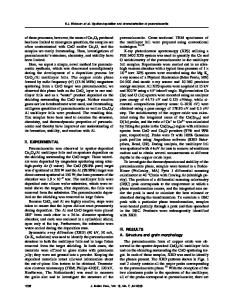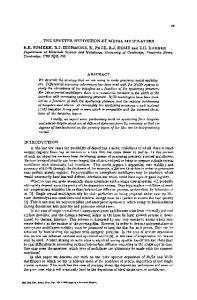Evidence of stress-induced tetragonal-to-monoclinic phase transformation during sputter deposition of yttria-stabilized
- PDF / 298,186 Bytes
- 7 Pages / 585 x 783 pts Page_size
- 71 Downloads / 343 Views
Qi Zhang Department of Physics, University of North Carolina, Chapel Hill, North Carolina 27599
Christopher A. Bower RTI International, Center for Materials and Electronic Technologies, Research Triangle Park, North Carolina 27709
Jeffrey Y. Thompson Department of Biomedical Engineering, University of Texas at San Antonio, San Antonio, Texas 78249; and Curriculum of Applied and Material Science, University of North Carolina, Chapel Hill, North Carolina 27599
Brian R. Stoner RTI International, Center for Materials and Electronic Technologies, Research Triangle Park, North Carolina 27709; and Curriculum of Applied and Material Science, University of North Carolina, Chapel Hill, North Carolina 27599 (Received 13 November 2006; accepted 18 January 2007)
Partially stabilized zirconia (PSZ) has been studied extensively, due to its high-temperature stability and stress-induced tetragonal (T)-to-monoclinic (M) martensitic phase transformation. This T ⇒ M phase transformation has been well-documented for bulk PSZ, but limited data exist for PSZ thin films. Data will be presented that support a stress-induced T ⇒ M transformation mechanism that occurs during sputter deposition in the presence of a substrate bias. Substrate bias (0–50 W) was originally applied to increase film density, modify microstructure, and vary film stress. The films were deposited using radio-frequency magnetron sputtering from a sintered yttria-stabilized zirconia target and were subsequently characterized using scanning electron microscopy (SEM), transmission electron microscopy (TEM), x-ray diffraction (XRD), and wafer bow measurement (for stress analysis). With no substrate bias, the films exhibited a columnar grain structure that was consistent with sputter-deposited films, with a majority T phase as determined by XRD. Under higher substrate bias, wafer bow measurements indicated a steady increase in compressive stress as substrate bias increased (maximum, 310 MPa at 50-W bias), while XRD indicated a corresponding increase in the percentage of the M phase. Both SEM and TEM analyses revealed a shift from a defect-free columnar structure to one consisting of lateral intracolumnar or transgranular defects for films deposited under substrate-bias conditions. It is hypothesized that these defects form as a result of stress relief in the growing film via the T ⇒ M phase transformation due to bias-induced compressive stress. I. INTRODUCTION
Developing transformation-toughened ceramic thin films has been a source of extensive research. Recent studies1–3 have investigated the effects of applying thin a)
Address all correspondence to this author. e-mail: [email protected] DOI: 10.1557/JMR.2007.0128 J. Mater. Res., Vol. 22, No. 4, Apr 2007
http://journals.cambridge.org
Downloaded: 30 Mar 2015
films to brittle substrates to increase fracture resistance. One material of interest is partially stabilized zirconia (PSZ), due to its high temperature stability and toughnessenhancing martensitic phase transformation.4,5 Yttria-stabilized zirconia (YSZ) thin
Data Loading...









